| GENE SLOVER'S US NAVY PAGES NAVAL ORDNANCE AND GUNNERY VOLUME 1, NAVAL ORDNANCE CHAPTER 14 ANTISUBMARINE WEAPONS |
| HOME INDEX Antisubmarine Weapons A. Antisubmarine warfare B. Depth charges C. Depth bombs D. Throwing weapons E. Nets and booms |
| E. Nets and Booms 14E1. General Efforts to block the entrances to harbors against surface vessels date back to the earliest times. The appearance of the high-powered, steel-hulled surface vessel, the submarine, and the torpedo have made the present-day problem of protecting ships at anchor increasingly difficult. The problem has evolved into one of defense against torpedoes. This defense is accomplished in two ways: by preventing the vessel carrying the torpedo from approaching within firing range, or by stopping the torpedo itself. See figure 14E1. |
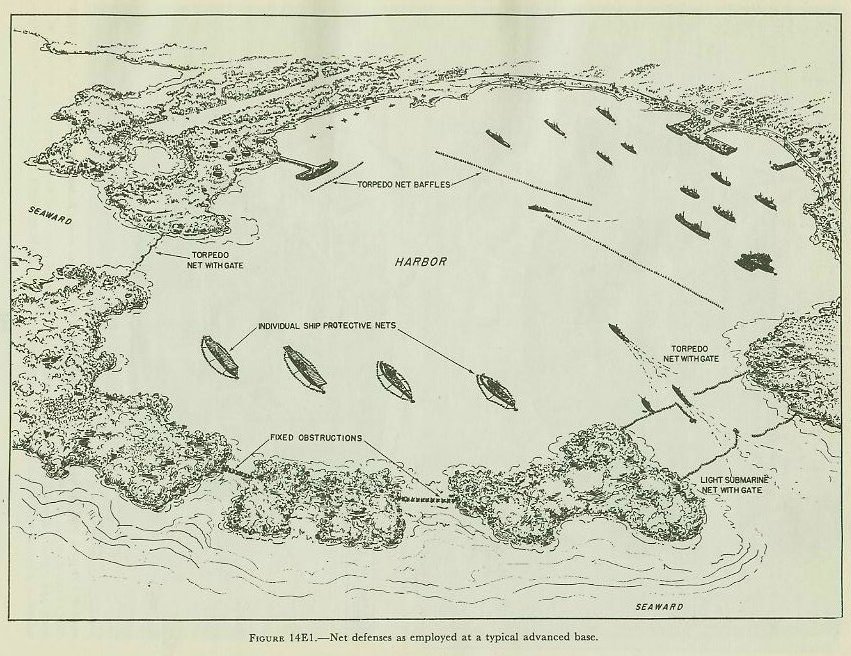 |
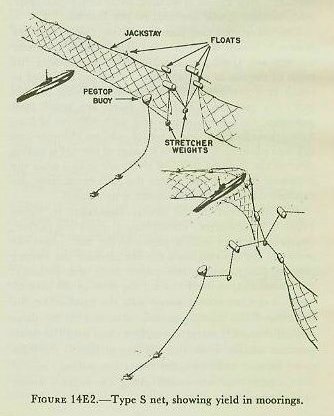 |
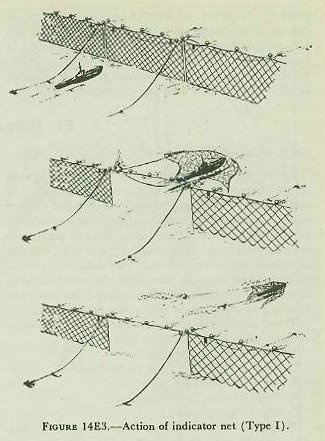 |
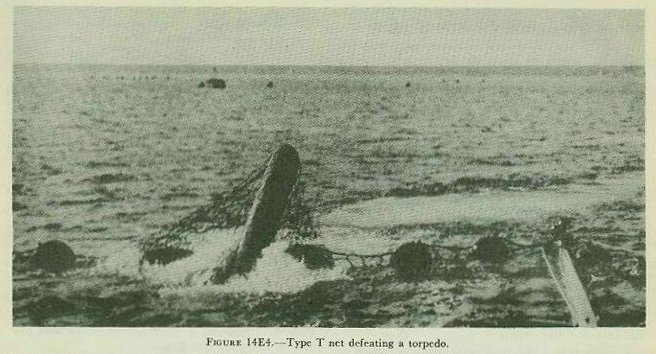 |
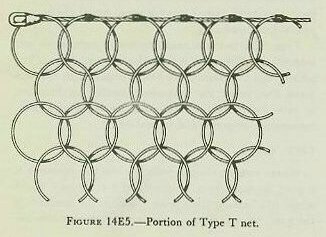 |
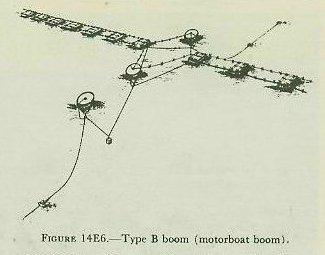 |
| There are five classes of nets and booms, with individual variations within each type. These are: 1. Type S net (antisubmarine). 2. Type I (Indicator) net (antisubmarine). 3. Type T net (antitorpedo). 4. Type B boom (antimotorboat). 5. Rigid obstructions. To protect ships at anchor in a harbor either (1) the harbor must be blocked off or (2) each ship must be protected individually. During World War II merely blocking off the harbor did not, in itself, give sufficient protection, because of the torpedo-carrying aircraft. Therefore, valuable ships and floating dry docks may be surrounded by a variation of the Type T net called an ISP (Individual Ship Protection) net. 14E2. Type S net (antisubmarine) The purpose of the Type S net is to block submarine attacks, or, if a submarine does break through, to reveal its presence to patrol craft. To prevent the passage of a submarine the net must be constructed of very heavy material and must have sufficient elasticity to absorb a sudden heavy strain without breaking. The three basic elements are: 1. The net, a fabric woven of heavy wire. 2. The flotation, a system of buoys and floats. 3. The moorings, the anchors and their connections. The standard submarine net is constructed of a diagonal mesh measuring 8 feet per side, assembled in lengths, called panels, which measure 300 feet. Nets are tailored to fit the depth of the water; they must reach the bottom without fouling on it. Two panels joined together longitudinally form a section, the lineal unit used in installing and when referring to large net systems. The net is woven around a top wire rope, called the jackstay, and around end and bottom wire ropes, called perimeter ropes. The jackstay supports the weight of the net, and it is to this that the flotation gear is secured. The net is floated by spherical or barrel-shaped buoys shackled to the jackstay. The moorings are designed both to keep the net in position against the force of tide and current, and to furnish the installation with the required elasticity. The typical mooring consists of four 6,000-pound stockless anchors, two on the seaward and two on the harbor side of the net. These anchors are laid in tandem at right angles to the net line. Elasticity is provided by slinging heavy iron cubes, called stretcher weights, in the bights of the mooring system. The stretcher weights and ends of the net are floated as illustrated in figure 14E2. A harbor entrance net has one detachable panel, called a gate, which may be swung open by a gate vessel to allow passage of friendly ships. In deep entrance channels the gate may be guarded by a submerged bottom net under the entrance. Such a net is supported by submerged buoys; it effectively seals the gate against submarines attempting to slip through, deeply submerged, while the gate is open. Of course the top of this net must be deeper than the draft of the largest friendly ship which will use the gate. 14E3. Type I (Indicator) net (antisubmarine) The purpose of this net is to indicate the position and movements of a submerged submarine. As the Type S net is extremely heavy and bulky, it requires heavy equipment to move it, lay it, and tend it. Therefore a relatively light, compact net, easily shipped to and installed in distant harbors, is required. |
| The Type I net is not designed to stop a submarine. Its strength requirements are that it must be capable of staying in position in all conditions of wind and weather, and that any section must hold together while being towed by a submerged submarine. The net is woven with a 4-foot diagonal mesh into panels 210 feet long and 50 feet deep. The net is not tailored to fit the depth of water, but the panels are fastened to each other until the net reaches the bottom. Any excess is secured by brailing and stopping, so that it will not foul on the bottom. The two distinctive features of the Type I net are burster clevises and the indicator floats. Burster devises are U-shaped shackles used to connect the mesh of the net to the jackstay. They are designed to break at a predetermined stress, thus freeing the net from the jackstay. Indicator floats are small steel pontoons, each containing a reel with 300 feet of line, a flotation chamber, and a pot of calcium chloride and calcium phosphide. When a panel of the net is pulled clear of the jackstay, tear-off strips are pulled from the indicator floats; water enters the pots containing the calcium compounds, and smoke is generated. The operation of the net is illustrated in figure 14E3. A submarine, attempting to enter the harbor, comes in contact with a panel of the net; when the stress on the net reaches a certain amount the burster devises part, freeing the panel from the jackstay; this panel drapes itself around the bow of the submarine; as the net moves away with the submarine, the indicator floats initially remain attached to the jackstay; the tear-off strips are pulled clear and the floats produce smoke; when the 300 feet of line in the indicator float is paid out, the floats are pulled clear of the jackstay and are towed along the surface astern of the submarine. |
| 14E4. Type T net (antitorpedo) The Type T net is used (fig. l4E4) to fence out torpedoes. It may be laid in any of the following ways: 1. As a continuous barrier across a harbor. 2. In a non-continuous baffle arrangement. 3. In individual ship-protection units. The Type S net must withstand the impact of the slow-moving large body of a submarine, the kinetic energy of which is diffused rapidly throughout a large area of the net. A torpedo, however, poses an entirely different problem to the net designer. A torpedo arrives at the net with a high degree of kinetic energy. At the critical instant of impact, because of the small diameter of the war-head nose and its high velocity, that total energy of the 300-horsepower torpedo is concentrated upon one element of the net. If that element fails, the net is defeated. The distinctive feature of the torpedo net is the grommet. Grommets are rings of steel wire with a breaking strain of 46 tons. As the net is woven, each grommet finally is passed through six other grommets (as shown in fig. 14E5), producing a fabric much like the chain-mail armor of feudal days. When the torpedo strikes, the force of its impact is expended in stretching, or elongating, the grommets, each one rendering against the adjoining grommets. Antitorpedo nets are attached both to the top and to the bottom of the flotation buoys, in order to protect against surface torpedo runs. The bottom of the torpedo net is left free to swing from the jackstay, thereby adding to its elasticity. The continuous barrier and the baffle methods of laying the Type T net are self-explanatory. However, neither of these affords protection against torpedo attack by plane. An Individual Ship Protection (ISP) net provides an answer for this problem. It is an antitorpedo net completely surrounding an individual ship. The net is held off about 60 feet from the sides of the ship by special spars and is attached to the anchor chain or mooring buoy. The main disadvantage of this net is tactical; that is, it interferes with the ability of a ship to get under way rapidly. |
| 14E5. Type B boom (antimotorboat) The purpose of the boom is to block passage of motor torpedo boats. Such a craft is built with an extremely light hull, because speed is its principal and virtually its sole protection. The Type B boom is designed with this weakness in mind. The distinctive feature of this boom is the baulk- a heavy iron-strapped wood-and-metal tank fitted with eyebolts and links for connecting it to the boom- jack-stays. Two watertight iron tanks occupy the interior of each baulk and provide flotation. Each baulk is fitted with four steel spike cutters whose points project outward from the baulk. The baulks are connected by upper and lower jackstays; along the upper jackstays, at intervals of 4 feet, are four-pronged steel star cutters. While this type of defense has been effective under favorable conditions, its limitations should be kept in mind. It is designed only for protection against very light craft and will not stop steel-hulled boats and heavier landing craft equipped with propeller guards. Moreover, the weight and shape of the baulks creates a definite problem where strong currents are encountered. 14E6. Rigid obstructions It is sometimes necessary to close entrances to harbors where the water is too shallow for efficient net operation. In such cases it is usually more efficient to employ some kind of rigid obstruction. These may take one of several forms: 1. Cribs. These are heavy structures built up from the bottom in the form of boxes of the heaviest timbers available and ballasted with rock or concrete. Heavy wire is rigged between them. 2. Concrete blocks. Where time and cost are not controlling factors, heavy tetrahedronal concrete blocks have been cast with their bases jointed to form a semibreakwater across the channel. |
| 3. Dolphins. Pile dolphins may be used where the nature of the bottom and availability of pile-driving equipment permit. These may be connected with jackstays and star cutters. 4. Blockships. The traditional means of closing a harbor is, of course, to sink a ship in the channel. This is very difficult to do correctly since, to be effective, the ship must be sunk on an even keel directly across the channel. Provisions should be made for very rapid, controlled flooding and for venting of trapped air. 14E7. Multiple installations Because of the specialized character of nets and booms no single installation can deal with all of the torpedo threats which may develop against an important base or anchorage. Often it is necessary to combine different types of barriers, either using one in support of another, or joining two or more into a single-line obstruction. A Type S net, for example, constitutes no very effective obstacle to a torpedo fired through its mesh. And to a motorboat designed to ride over low obstacles a torpedo net would not be a much more positive barrier than a motorboat boom would be to a torpedo fired under it. Sometimes the only solution is a combination of two or more types of defense. In practice any or all of the possible combinations may be used, from simply doubling a line of one kind of net to combinations of three separate types. Standard Type S moorings for a double line will readily carry a Type T net in place of the second Type S net. Such a barrier, while not as formidable to either a submarine or a torpedo as a double line of its specific antidote, will still stop most torpedoes fired into it and, if well patrolled, will leave little chance that a submarine will pass through undetected. This combination is a compromise, but a thoroughly practical compromise. Without unlimited reserves of material it often constitutes all that can be done in a given situation. The double-line Type S net installation provides as nearly complete protection against submarines as can be established at the existing stage of net development. But a review of actual war experience in this field indicates that, when considered on the basis of calculated risk, the expense in materials and transportation capacity is justified only where there is both very great risk of determined attack by submarines and an extremely important prize inviting such attack. The case against double-line installation applies in a lesser degree to torpedo nets. They too, with their flotation and moorings, impose a heavy load upon war-burdened transportation and maintenance facilities. Torpedo net is used in greater quantities than any other type of heavy installation. A practice which would double the mileage of net required would almost inevitably entail leaving some naval anchorages entirely unprotected. Type SBT net is a combination of submarine and torpedo net lines with a motorboat boom (fig. 14E6) added, the submarine net being installed at the seaward line, using the motorboat baulks for flotation. It provides protection against three types of attack: submarine, torpedo, and motorboat. 14E8. Gates Where nets or booms entirely close the entrance to a port, passage must be provided for friendly vessels while still barring the enemy. This is the function of the gate. Net and boom gates are simply movable sections of the barrier so rigged that they may be opened to permit the passage of friendly craft. When closed, such gates will be as strong as or stronger than the other sections of the barrier. Gates are classified according to use as main, emergency, and side. All must be so rigged that they may be operated easily and rapidly under all conditions of weather and sea, will be entirely secure when closed, and will be controllable by the officers operating the portís defenses. They are classified according to design as horizontal and vertical. The horizontal gate is operated by swinging it open, still floated by its buoys, until the passage is cleared. The vertical gate is lowered at one end or at both ends until sufficiently submerged to permit vessels to pass over it. 14E9. Summary of net defenses In considering the type of net defenses to employ, one must give thought to transportation facilities, weight of the net and accessories, net-laying and tending vessels available, and tactical requirements. Type S and Type T nets are very heavy and bulky, and require the use of large laying and tending vessels. The Type I nets are made in various weights, varying from fairly heavy to extremely light. The adage among net personnel states that ďa net is no stronger than its patrol.Ē These patrols must keep watch not only for the enemy but also for damage to the net by currents, weather, and corrosion. The most important factor in maintaining effectiveness of any net installation is a continuous and alert patrol. |